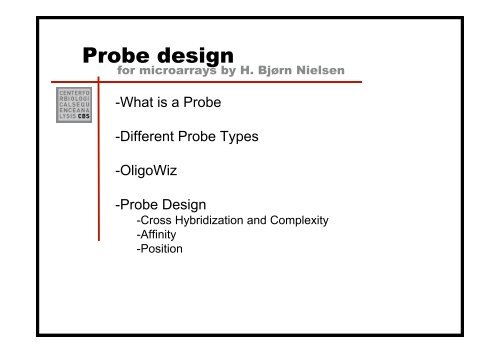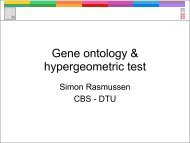Create successful ePaper yourself
Turn your PDF publications into a flip-book with our unique Google optimized e-Paper software.
<strong>Probe</strong> <strong>design</strong><br />
for microarrays by H. Bjørn Nielsen<br />
-What is a <strong>Probe</strong><br />
-Different <strong>Probe</strong> Types<br />
-OligoWiz<br />
-<strong>Probe</strong> Design<br />
-Cross Hybridization and Complexity<br />
-Affinity<br />
-Position
An Ideal <strong>Probe</strong><br />
must<br />
- Discriminate well between its intended<br />
target and all other targets in the target<br />
pool<br />
- Detect concentration differences under<br />
the hybridization conditions
<strong>Probe</strong> Type<br />
comparisons<br />
PCR<br />
products<br />
Oligos<br />
Affymetrix<br />
GeneChip<br />
Advantages<br />
Inexpensive<br />
Linkers can be applied<br />
Can be <strong>design</strong>ed for many<br />
criteria<br />
Easy to handle<br />
Normalized concentrations<br />
Linkers can be applied<br />
High quality data<br />
Standardized arrays<br />
Fast to set up<br />
Multiple probes per gene<br />
Disadvantages<br />
Handling problems<br />
Hard to <strong>design</strong> to avoid crosshybridization<br />
Unequal amplification<br />
Expensive<br />
(Dkk. 100-150 per oligo)<br />
Expensive<br />
Arrays available for limited number<br />
of species
OligoWiz a Tool<br />
for flexible probe <strong>design</strong><br />
A client-server application for <strong>design</strong>ing<br />
oligonucleotides for microarrays
Download OligoWiz<br />
and try the sample data set<br />
Go to<br />
www.cbs.dtu.dk/services/OligoWiz/OW2<br />
Linked from course program<br />
Download the<br />
Program: OligoWiz2.jar<br />
Sample data set: yeast.fsa<br />
Annotation file: yeast.ann<br />
Execute OligoWiz2 with the sample data set:<br />
Double click the icon (PC/Mac)<br />
java –jar OligoWiz2.jar (UNIX)
How to Avoid<br />
cross-hybridization<br />
From Kane et al. (2000) we learn that a 50’mer probe can<br />
detect significant false signal from a target that has<br />
>75-80% homology to a 50’mer oligo<br />
or a continuous stretch of >15 complementary bases<br />
If we have substantial sequence information on the given<br />
organism, we can try to avoid this by choosing oligos that are<br />
not similar to any other expressed sequences.
<strong>Probe</strong> Specificity<br />
Hughes et al. 2001
Mapping Regions<br />
5’<br />
without similarity to other transcripts<br />
The Sequence we want to <strong>design</strong> a probe for<br />
50 bp<br />
Regions suitable<br />
for probes<br />
3’<br />
BLAST hits >75% &<br />
longer than 15bp
Filtering Self Detecting<br />
50 bp<br />
BLAST hits out<br />
The Sequence we want to <strong>design</strong> a oligo for<br />
5’ 3’<br />
Sequence identical or<br />
very similar to the query<br />
sequence<br />
Therefore no BLAST hits with homology > 97% and<br />
with a ‘hit length vs. query length’ ratio > 0.8,<br />
are considered.<br />
BLAST hits >75%<br />
& longer than 15bp
Cross-hybridization<br />
expressed as a ‘homology score’<br />
Only BLAST hits that passed filtering are considered<br />
If m is the number of BLAST hits considered in position i.<br />
Let h=(h1 i ,...,hm i ) be the BLAST hits in position i in the oligo<br />
100×<br />
n −<br />
BLAST max score =<br />
Where n is the length of the oligo<br />
i<br />
∑ = 1<br />
n<br />
max( h1<br />
,..., hm )<br />
100×<br />
n<br />
BLAST hits {<br />
Max hit in pos. i<br />
i<br />
i<br />
Oligo<br />
100%<br />
0
Similar Affinity<br />
for all oligos<br />
Another way of ensuring a optimal discrimination between<br />
target and non-target under hybridization is to <strong>design</strong> all<br />
the oligos on an array with similar affinity for their targets.<br />
This will allow the experimentalist to optimize the<br />
hybridization conditions for all oligos by choosing the right<br />
hybridization temperature and salt concentration.<br />
Commonly Melting Temperature (Tm) is used as a<br />
measure for DNA:DNA or RNA:DNA hybrid affinity.
Melting Temperature<br />
difference<br />
1000ΔH<br />
Tm(<br />
i)<br />
= − 273.<br />
15 + 16.<br />
6log[<br />
Na+<br />
]<br />
Ct<br />
A + ΔS<br />
+ R ln( )<br />
4<br />
Where ΔH (Kcal/mol) is the sum of the nearest neighbor<br />
enthalpy, A is a constant for helix initiation corrections, ΔS is<br />
the sum of the nearest neighbor entropy changes, R is the<br />
Gas Constant (1.987 cal deg-1 mol-1) and Ct is the total<br />
molar concentration of strands.<br />
ΔTm<br />
score =<br />
Tm(i) -<br />
∑<br />
Tm(i)<br />
N<br />
Where N is all oligos in all sequences.<br />
1<br />
N
Tm distributions<br />
for 30’mers and 50’mers
ΔTm Distribution<br />
for oligo length intervals
Avoid self annealing oligos<br />
Sensitivity may be influenced<br />
<strong>Probe</strong>s that form strong hybrids with it self i.e. probes<br />
that fold should be avoided.<br />
But, accurate folding algorithms like the one employed<br />
by mFOLD or RNAfold, is too time consuming, for large<br />
scale folding of oligos.<br />
Time consumption:<br />
mFOLD ~2 sec / 30’mer<br />
Pr. gene (500bp) ~16 min.
Folding an oligonucleotide<br />
The alignment is<br />
based on<br />
dinucleotides<br />
Substitution matrix is<br />
based on binding<br />
energies<br />
an approximation<br />
{<br />
{<br />
{<br />
AT TG CT .........................................................................................CG GT TT<br />
{<br />
{<br />
{<br />
AT TG CT ........................................................................................CG GT TT<br />
. .<br />
. .<br />
. .<br />
.<br />
. .<br />
. . .<br />
. . . .<br />
. . . .<br />
. . .<br />
Dynamic programming:<br />
alignment to inverted self<br />
.<br />
.<br />
.<br />
.<br />
.<br />
.<br />
Minimal loop size border
Folding a lot of oligos<br />
a fast heuristic implementation<br />
AT TG CT .........................................................................................CG GT TT<br />
AT TG CT ........................................................................................CG GT TT<br />
. .<br />
. .<br />
. .<br />
Full dynamic programming<br />
calculation for first probe<br />
.<br />
. .<br />
. . .<br />
. . . .<br />
. . . .<br />
. . .<br />
Dynamic programming<br />
calculation for second<br />
etc. probe<br />
.<br />
.<br />
.<br />
.<br />
. .<br />
.<br />
Super-alignment matrix<br />
.<br />
.<br />
. .<br />
. . .<br />
. . . .<br />
. . . .<br />
. . .<br />
. .<br />
. .<br />
. .<br />
Minimal loop size border<br />
Last probe
Reasonably folding prediction<br />
compared to mFOLD
<strong>Probe</strong>s With Very Common<br />
sub sequences may result in unspecific signal<br />
If the sub-fractions of an oligo are very common we<br />
define it as ‘low-complex’<br />
Oligo with low-complexity:<br />
AAAAAAAGGAGTTTTTTTTCAAAAAACTTTTTAAAAAAGCTTTAGGTTTTTA<br />
(Human)<br />
Oligo without low-complexity:<br />
CGTGACTGACAGCTGACTGCTAGCCATGCAACGTCATAGTACGATGACT<br />
(Human)
Low-complexity<br />
expressed as a score<br />
For a given transcriptome a list of information content<br />
from all ‘words’ with length wl (8bp) is calculated:<br />
f(w) f(w)<br />
I(w) = log 2 4<br />
tf(w) tf ( w)<br />
Where f(w) is the number of occurrences of a pattern and<br />
tf(w) is the total number of patterns of length wl.<br />
A low-complexity score for a given oligo is defined as:<br />
complexityLow-complexity<br />
score = 1-<br />
normalized = 1-norm<br />
Where norm is a function that normalizes to between 1 and 0,<br />
L is the length of the oligo and<br />
W i is the pattern in position i.<br />
wl<br />
i 1<br />
( ∑ =<br />
L-wl+<br />
1<br />
I(w<br />
i<br />
) )
Location of Oligo<br />
within transcript<br />
Labeling include reverse transcription of the mRNA<br />
and is sensitive to:<br />
- RNA degradation<br />
- Premature termination of cDNA synthesis<br />
- Premature termination of cRNA transcription (IVT)<br />
A ‘Position Score’ reflecting this (eukaryotes):<br />
Position score= (1-drp) Δ3’end<br />
Where drp is the chance of labeling termination pr. base
Placement of multiple oligos<br />
in respect to annotation<br />
Load annotation file:<br />
Project/project properties : annotation file<br />
Place 10 oligos in each gene:<br />
Tools/oligo placement
Export the probes<br />
to a file<br />
Export the oligos to a FASTA file:<br />
File/Export oligo<br />
Have a look at it
Place probes<br />
relative to annotation<br />
Use the Tools/oligo placement tool, to place Oligos:<br />
1) Exclusively in exons<br />
2) Exclusively in introns<br />
3) Exclusively on the exon-intron boundary<br />
Using regular expressions<br />
The “Introduction to regular expressions” Is linked from the<br />
course program.<br />
Note: the yeast.ann file consists of lists of: {E,I,D,A,),(,. }<br />
E=exon, I=intron, D= donor site, A=acceptor site, )(= end<br />
and beginning of exon and “.” = UTR









